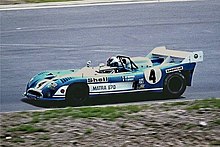Gérard Ducarouge
Gérard Ducarouge (born October 23, 1941 in Paray-le-Monial , † February 19, 2015 ) was a French engineer and racing car designer in Formula 1 .
life and career
Matra
After studying at the Ecole Nationale Technique d'Aeronautique , Ducarouge began working for Matra in 1966, initially on the MS620 sports car , with which u. a. Jean-Pierre Beltoise started in races. In 1968 Matra entered Formula 1 as a chassis supplier for Tyrrell and with its own team. Ducarouge was responsible for the chassis development. After the end of its Formula 1 involvement in 1972, Ducarouge concentrated on developing the MS670 for the Le Mans 24-hour race , in which the driver pairings Henri Pescarolo / Graham Hill and François Cevert / Howden Ganley made the first attempt a double victory could be celebrated. In the following two years, Matra won the 24-hour race with Henri Pescarolo and Gérard Larrousse .
Ligier
At the end of 1974 Matra ended his racing engagements and sold the team to Guy Ligier . In 1975 Ducarouge worked on the Ligier team's first Formula 1 car , the JS5 , which made its debut in 1976 with Matra engines and Jacques Laffite at the wheel. In 1977 Laffite won the first time at the Swedish Grand Prix . For 1979 Ducarouge designed the JS11, a ground-effect car with which Laffite won the first two races of the season. Patrick Depailler scored yet another victory and at the end of the season, third place remained in the constructors' championship. The most successful season was 1980 with the JS11 / 15 and the drivers Laffite and Didier Pironi with second place in the constructors' championship.
Alfa Romeo
After parts of the Ligier team were sold to Talbot , Ducarouge moved to Autodelta in Italy in 1981 , where he developed the Alfa Romeo 182 for the 1982 season . However, Alfa Romeo shifted development from Autodelta to Paolo Pavanello's Euroracing team and Ducarouge lost his position as technical director. Ducarouge's Alfa Romeo 183T continued to be used by Osella in 1984 as the Osella FA1F ; Derivatives from this model remained in use there until 1988 ( Osella FA1L ).
lotus
Ducarouge then moved up to the 1983 Formula 1 Team Lotus and built the Lotus-Renault 94T, with Elio de Angelis in 1984 took third place in the World Cup. From 1985 bis 1987 celebrated Ayrton Senna in the Lotus 97T , 98T and 99T its Gérard Ducarouge first six victories. After Senna's move to McLaren , Ducarouge stayed with Lotus for a year and then went back to France to join Gérard Larrousse's newly formed team.
The Larrousse team used Lola chassis developed by Ducarouge and Lola's Chris Murphy . In 1991 Ducarouge returned to Ligier, where he worked as technical director until mid-1994, when Flavio Briatore took over the team. Until 2002 Ducarouge was head of development for the Renault Espace F1 project, in which a V10 Renault engine from Formula 1 and a semi-automatic transmission from Williams were integrated into an Espace prototype. Ducarouge has been Technical Director at Venturi since 2003 .
Gérard Ducarouge died after being treated for three years in the American Hospital Paris in Neuilly-sur-Seine .
literature
- Doug Nye: Theme Lotus, 1956-86: Chapman to Ducarouge . Motor Racing Publications Ltd, 1986, ISBN 0947981098 .
Web links
Individual evidence
- ↑ Gilles Gaignault: L'engineer Gérard Ducarouge est mort. (Obituary on autonewsinfo.com, French, accessed February 25, 2015).
- ↑ Zmarł Gérard Ducarouge (f1.autoklub.pl, Polish, accessed on February 25, 2015)
| personal data | |
|---|---|
| SURNAME | Ducarouge, Gérard |
| BRIEF DESCRIPTION | French racing car designer |
| DATE OF BIRTH | October 23, 1941 |
| PLACE OF BIRTH | Paray-le-Monial |
| DATE OF DEATH | 19th February 2015 |

